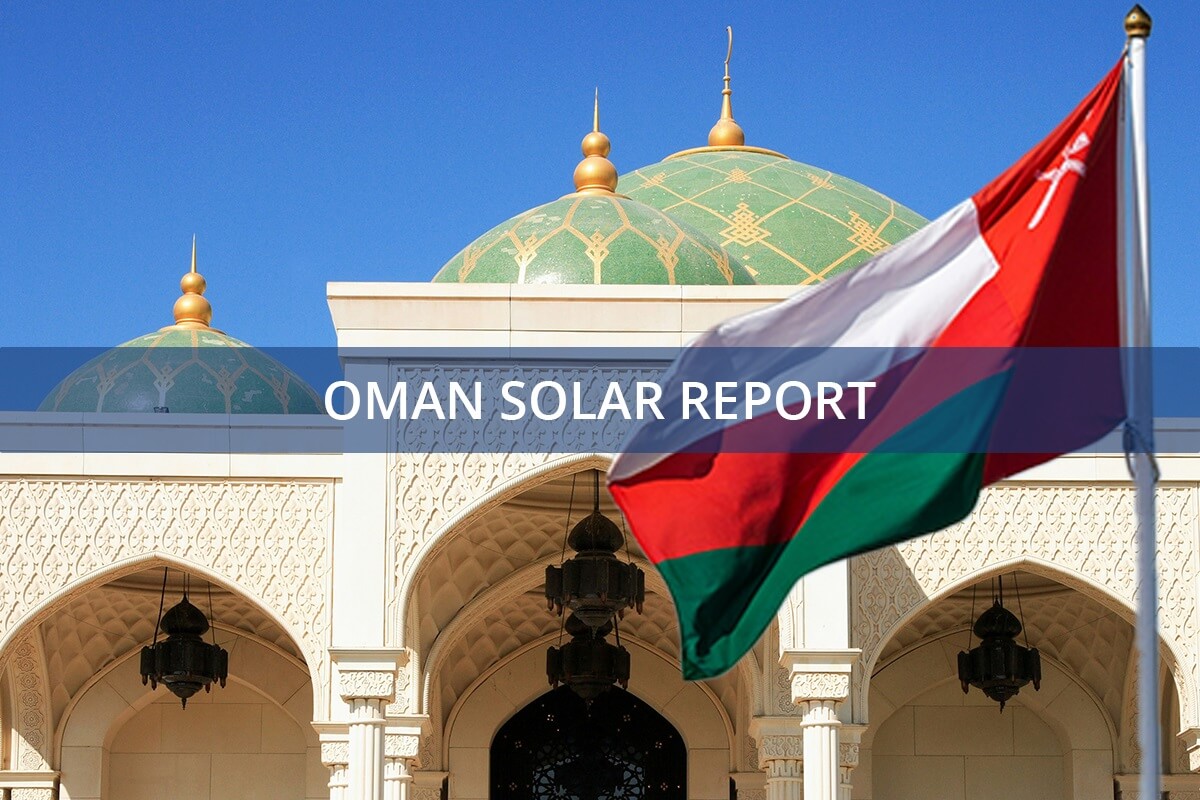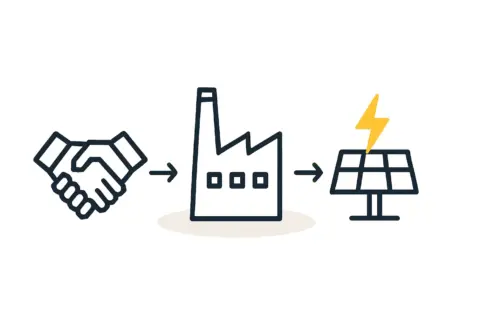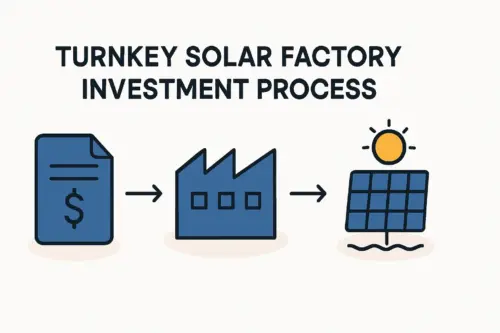A Business Model for a 50 MW Solar Factory in Oman: Targeting the Commercial and Industrial Sector
While the global energy narrative often focuses on established markets, one of today’s most significant industrial opportunities is emerging in nations traditionally known for hydrocarbon wealth. Guided by its ambitious Vision 2040, Oman is actively diversifying its economy and energy sources, creating a compelling opening for local manufacturing in the solar sector.
The prospect of entering this industry can seem daunting, as it is often associated with massive, billion-dollar ‘gigafactories’. This article presents a different, more accessible approach: a complete turnkey model for a 50 MW solar factory in Oman, designed specifically to serve the nation’s growing Commercial and Industrial (C&I) sector.
Our analysis explores how a lean, strategically focused operation can achieve profitability and support the national vision with a manageable initial investment. For those exploring this path, understanding how to start a solar panel manufacturing business is a foundational first step.
The Strategic Opportunity: Why Oman’s C&I Solar Market is Primed for Growth
The case for local solar module manufacturing in Oman is not speculative; it’s grounded in clear national policy and tangible market demand. The country’s current reliance on imported solar panels presents a strategic gap for local entrepreneurs—an opportunity supported by several key drivers.
Oman Vision 2040: A National Mandate for Renewables
At the heart of this opportunity is Oman Vision 2040, the country’s long-term strategy for economic diversification and sustainability. A key objective is to raise the share of renewable energy in the electricity mix to 30% by 2030 and 39% by 2040. This top-down commitment creates a stable and predictable environment for investment in the renewable energy supply chain.

Targeted Policy from the APSR
To further stimulate the market, Oman’s Authority for Public Services Regulation (APSR) has launched initiatives specifically targeting large electricity consumers. These policies enable commercial and industrial facilities to install their own solar power systems above 1 MW, directly addressing their high daytime energy needs and reducing operational costs. This has unlocked a previously underserved segment, creating immediate demand for high-quality, locally available solar modules.
The ‘Made in Oman’ Advantage
Establishing a local manufacturing facility offers distinct competitive advantages over relying on imports. These include:
- Reduced Logistics Costs and Lead Times: Eliminating international shipping complexities and delays means faster delivery to project sites.
- Greater Supply Chain Security: A domestic factory insulates projects from global supply chain disruptions.
- National Economic Contribution: Local manufacturing creates skilled jobs and supports national industrialization goals, potentially leading to preferential treatment in government and private tenders.
The Lean Manufacturing Blueprint: A 50 MW Turnkey Model
Contrary to the belief that solar manufacturing requires immense scale, a 50 MW facility represents an ideal strategic entry point. It is large enough to achieve economies of scale for the C&I market yet small enough to be established with a lean operational footprint and a manageable capital outlay. Based on experience from J.v.G. turnkey projects, this phased approach has proven effective in emerging markets.
Investment and Capital Expenditure (CAPEX)
The initial capital requirement is a primary barrier for many industrial projects, but a lean, semi-automated 50 MW facility significantly lowers this hurdle. The estimated initial solar panel manufacturing plant cost for such a project is between USD 5–7 million. This investment typically covers core production machinery, facility setup, technology transfer, and initial staff training.
Ready to make big Profits?
The solar Industry is Booming
WE HELP NEWCOMERS to the solar industry start their own solar module production line. Customers can make BIG PROFITS by selling modules and finding investors, without wasting money and time on things they don't need!
Operational Requirements: Factory and Workforce
The physical footprint for a 50 MW line is modest, requiring a facility of approximately 3,000 square meters. This space accommodates the production line, raw material storage, and finished goods warehousing.

A single-shift operation can run effectively with a workforce of just 25–30 employees, including line operators, quality control technicians, maintenance staff, and administrative personnel. This lean structure keeps operational overheads low, contributing to a faster path to profitability.
The Technology: Semi-Automated Production
At the 50 MW scale, a fully automated production line is often an unnecessary expense. A semi-automated approach strikes the ideal balance of efficiency, flexibility, and cost-effectiveness. While key processes are automated to ensure quality and throughput, certain material handling stages remain manual. This blend reduces the initial CAPEX and allows for greater adaptability as product technologies evolve. A turnkey solar manufacturing line solution ensures that all machinery works together seamlessly and the production process is optimized from day one.
A Focused Go-to-Market Strategy for the C&I Sector
The success of a 50 MW factory hinges on a targeted market strategy, not a broad one. Oman’s C&I sector is the ideal focus, as its key clients—manufacturing plants, shopping malls, large office buildings, and agricultural operations—have high daytime electricity consumption that aligns perfectly with solar power generation.

Product Specialization
Instead of competing in the commodity residential market, the factory can specialize in producing modules optimized for C&I applications. This could include modules with higher power outputs, larger formats for easier installation on expansive rooftops, and enhanced durability to withstand the region’s high temperatures and arid conditions.
Sales and Distribution Channels
A direct B2B sales approach is most effective, focusing on three primary channels:
- Direct Sales: Engaging directly with large industrial and commercial energy consumers looking to invest in their own solar installations.
- Partnerships with EPCs: Collaborating with local Engineering, Procurement, and Construction (EPC) companies that design and build solar projects.
- Supplying Solar Developers: Working with project developers who are building medium-scale solar farms for C&I clients.
Financial Viability and Path to Profitability
This combination of a lean operational model, manageable CAPEX, and a focused go-to-market strategy creates a robust business case. By avoiding the high overheads of a gigawatt-scale factory and targeting a high-value market segment, a 50 MW facility in Oman can realistically achieve operational profitability within two to three years. This model prioritizes sustainable growth and de-risks market entry for entrepreneurs new to the solar industry.
Frequently Asked Questions (FAQ)
Do I need a technical background in solar to start this business?
No. While technical understanding is beneficial, the primary requirement is strong business and project management acumen. A turnkey partner like J.v.G. provides the necessary technical expertise, from factory planning and machine procurement to staff training and process optimization.
Why not target the residential market?
The C&I market offers several advantages for a new manufacturer. Project sizes are significantly larger, which leads to more efficient sales cycles. Furthermore, government policies in Oman are currently geared toward stimulating this large-consumer segment, providing a clearer and more immediate source of demand.
How long does it take to get a 50 MW factory operational?
With a structured, turnkey approach, a 50 MW solar module factory can typically progress from final planning to the start of production in approximately 9 to 12 months. This timeline includes machinery procurement, shipping, installation, and commissioning.
What are the main challenges for a new manufacturer in Oman?
The primary challenges typically involve developing a local supply chain for certain raw materials and securing a skilled workforce. A well-structured business plan anticipates these issues by establishing relationships with international suppliers from the outset and incorporating a comprehensive training program for local employees, often facilitated by the turnkey line provider.
Conclusion: Seizing the ‘Made in Oman’ Solar Opportunity
Oman’s decisive move toward a renewable energy future has created a distinct and actionable opportunity for industrial investment. The model for a 50 MW factory focused on the C&I sector isn’t about competing with global giants; it’s about serving a specific, growing domestic market with precision and efficiency.
For entrepreneurs and established business leaders in the region, this presents a unique chance to build a profitable enterprise that directly supports Oman’s Vision 2040. By leveraging a lean manufacturing model and expert guidance, entering the solar panel industry is more accessible than ever. This is an opportunity to build local industrial capacity and power the nation’s future.






